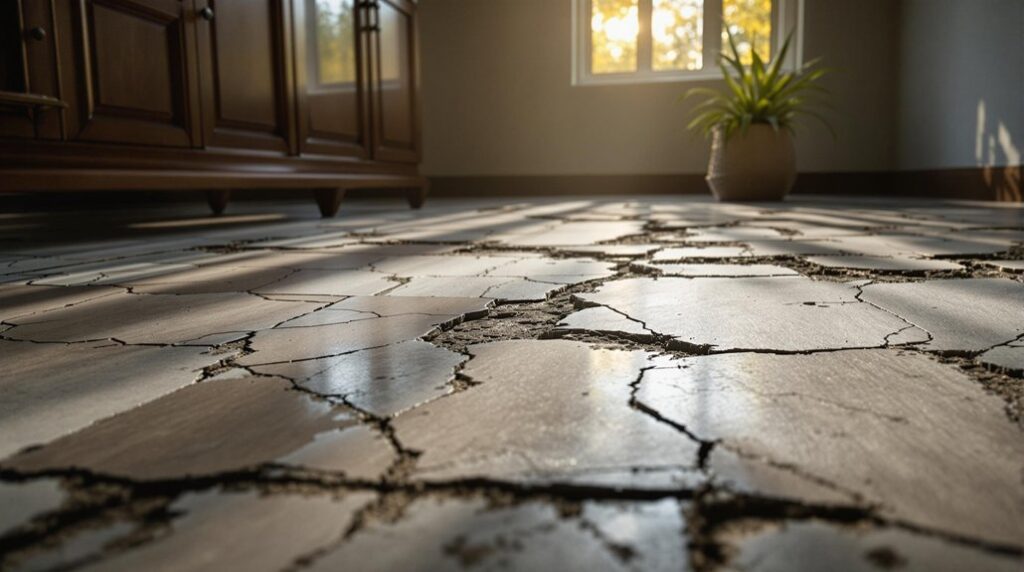Key Takeaways:
- Choosing the wrong flooring material can significantly devalue your property.
- Proper subfloor preparation is crucial to avoid costly mistakes.
- Monitoring moisture levels is essential to prevent unsightly damage.
Common Flooring Mistakes That Impact Property Value
As a Charlotte investor, you know that every decision you make impacts your property's value. Flooring is no exception, and mistakes here can quickly erode your investment. Imagine choosing the wrong material or ignoring essential subfloor preparation—these missteps could cost you dearly.
Even the smallest oversight in moisture levels might lead to unsightly damage. So, how do you sidestep these pitfalls and protect your investment? The answer lies in understanding each potential error and making informed choices.
Choosing the Wrong Material
When it comes to choosing flooring for your home, opting for the wrong material can seriously impact its value. You mightn't realize it, but material longevity and aesthetic trends play essential roles in maintaining or boosting property value. Sustainable and eco-friendly materials are gaining popularity, especially in urban areas, offering an appealing choice for environmentally conscious buyers. Potential buyers often perceive outdated or mismatched flooring as a red flag, signaling future renovations or repairs. In the U.S. market, aligning your flooring with current aesthetic trends and ensuring its longevity can greatly enhance appeal. For instance, hardwood flooring is timeless and offers excellent return on investment. Meanwhile, luxury vinyl tiles provide durability and style, perfect for high-traffic areas.
Ignoring Proper Subfloor Preparation
Neglecting proper subfloor preparation can wreak havoc on your home's flooring, potentially diminishing its value and appeal. You need to prioritize subfloor inspection to avoid costly mistakes. Uneven surfaces not only affect the appearance but also lead to functionality issues. Ignoring this step increases the risk of moisture damage, causing warping and mold growth. Dirty subfloors compromise flooring adhesion, resulting in loose tiles and floorboards. Subfloor preparation guarantees durability and prevents future issues. Take a closer look at the impact:
| Problem | Consequence | Solution |
|---|---|---|
| Uneven Surfaces | Affects appearance | Level the subfloor |
| Moisture Damage | Causes warping | Address moisture issues |
| Poor Adhesion | Leads to loose flooring | Clean and prime the subfloor |
| Long-term Issues | Costly repairs | Inspect and repair early |
Don't skimp on preparation—it's essential for enduring results.
Overlooking Moisture Levels and Acclimation
Subfloor preparation sets the stage for your flooring, but it's equally important to address moisture levels and acclimation. Ignoring these factors can lead to costly mistakes.
Use moisture measurement tools like pinless meters to guarantee wood flooring maintains a moisture content between 6% and 9%. This prevents swelling, shrinking, or cracking.
The acclimation process is vital, allowing materials like wood and vinyl to adjust to the room's climate before installation. You should schedule delivery a week in advance and maintain a stable environment for 48 hours. This careful planning avoids warping and maintains warranty protection.
The Pitfalls of DIY Installation
Taking on a DIY flooring project can feel like an exciting adventure, but it's important to avoid common pitfalls to protect your home's value.
Costly errors often stem from inadequate preparation. For instance, not preparing the subfloor or taking incorrect measurements can lead to expensive mistakes.
Installation tips include ensuring the subfloor is clean and flat and adding 10% extra material to your order to cover errors or future repairs.
Don't overlook the importance of using proper tools and maintaining consistent expansion gaps for a professional finish.
Skimping on supplies like underlayment and tile spacers can compromise the flooring's longevity.
Neglecting Post-Installation Care and Maintenance
Even the most stunning flooring can lose its charm without proper care. Regular flooring inspections and maintenance schedules are essential to preserving your investment.
Hardwood floors, for instance, need periodic refinishing to keep their luster and avoid scratches. Overlooking maintenance in high-traffic areas leads to premature wear, diminishing your property's appeal. Homebuyers prioritize well-maintained floors, so neglecting them can drastically reduce your home's value.
RELATED CONTENT
Consistent upkeep, like cleaning and timely repairs, extends flooring lifespan and enhances resale attractiveness. Different flooring types have specific needs; understanding and addressing these guarantees longevity.
Without proper care, you're not just risking costly repairs but also the health and safety of occupants. Keep your floors in top shape to maintain your property's worth.
Conclusion
Key Flooring Strategies for Savvy Investors
Hey there, savvy investor! Let's chat about how you can sidestep those pesky flooring disasters and keep your property's value on the up and up. Think of your home as a creative masterpiece, where every detail—from subfloor prep to moisture control—is like adding the perfect brushstroke. You definitely don't want DIY slip-ups or neglect to dull your investment's shine, right? So, here's the plan: give your floors the TLC they deserve with careful maintenance and attention to detail. By nailing these essentials, you're not just avoiding potential pitfalls—you're setting the stage for greater success and boosting your property's resale potential. Ready to turn those flooring challenges into opportunities? Let's make it happen!
No related posts.



















